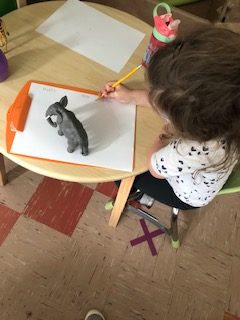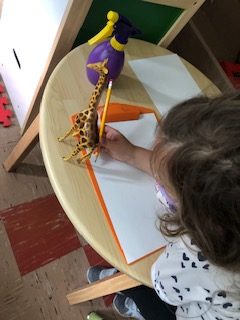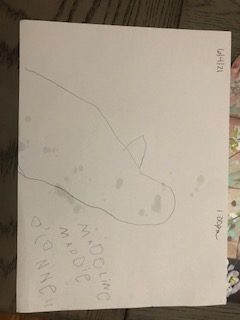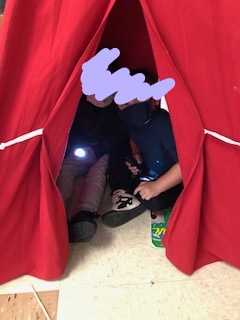Shadows and Sun Fun!
Developed by Danielle Fonseca, PCM Play Intensive 2021
(FOCUS: Preschool & Pre-K, Kindergarten, Science, Technology, Engineering and Mathematics (STEM), Visual & Performance Arts, Language & Literacy)
This lesson investigates the science concept of shadows and how shadows can change and move throughout the day based on the sun. (Discuss sun’s properties prior to the lesson.) Students will observe how different times of day and positions of the sun will move a shadow or alter its shape. The student chooses an object to prop up on the paper for the challenge (e.g., toy train or toy elephant). They will observe and take a picture of the shadow location beside the object every few hours using a camera, iPad, or cell phone. They will discover and discuss how the shadow changes throughout the day.
Then students will get to create a drawing or painting of different shadows from either the same or a different object of their choice. This painting could be from shadows of an animal figurine, a vase of flowers, or a block structure they built. The possibilities are endless!
How does this inquiry into shadows impact the whole child? This activity will help them connect to nature.
Materials
- Camera, iPad, or cell phone for taking shadow pictures (Be sure they are charged!)
- Cardstock or long poster paper
- Pencil
- Objects to place over paper to observe
- Tape (to secure object in place)
- Paintbrushes and dark-colored paints (to best represent shadows) for painting OR markers and colored pencils for drawing
- Science Journal (for older students in K)
Set Up
- Lay out the paper on a long table outside or on the ground where it is as flat and smooth as possible.
- Have the object(s) standing upright on the edge of the paper where you will see the shadow behind it, working with the position of the sun.
- Have camera/iPad/phone charged and ready to record pictures of shadow at each of the interval times (9 am, 12 pm, etc.)
- Have pencil ready to trace image to then create drawing or painting of shadow; have preferred art materials ready for shadow picture creation.
Student’s Job
How can you trace and then draw or paint a shadow from a chosen object(s) using the position of the sun? Or, if inside, using artificial light like a flashlight or lamp?
Why explore shadows in this way? Some examples of authentic connections:
- Artists who work with silhouettes or who take a more abstract image and transform it by adding layers.
- Shadow puppets from Thailand, where, in the theater, they are used make things appear big that are actually small
- Landscapers, architects, school building developers, etc. think about where sunlight is and where shade can be found.
- Telling time when we didn’t have cell phones!
Steps:
- Pick a sunny day. Lay out a long or large-sized poster or cardstock paper (you can tape a few cardstock papers side-by-side to create the length effect) on a smooth, flat surface (e.g., floor, deck, countertop) that has direct sun access.
- Position the object(s) to stand upright at the edge of the paper where the sun shines and you will be able to see the shadow move as you take photos of the changes.
- Set the timer for the different times of day to observe the shadow and snap a picture (e.g., 9:00am, 12:00pm, 3:00pm) If older students wish, they can jot notes and pictures of what they notice in a Science Journal.
- At the time when the shadow seems to be directly behind the object, grab the pencil and begin to trace the shadow that is behind it! Be sure that the object does not move. You may want to place tape under it to secure it.
- Once the tracing is completed, retrieve art materials of preference and begin creating the shadow representation in a drawing/painting. Have fun with this!
- Afterwards, look at the shadow pictures to observe the differences in the position of it throughout the day and discuss why the shadow moves.
Further Challenges:
Consider the following open-ended questions to reflect and lift level of learning:
- What causes a shadow?
- Where is the light (sun)?
- Where is the object making the shadow?
- Do all objects show the shadow moving in the same direction as the sun position moves?
This investigation is best done outside, but in the event there’s inclement weather or it’s nighttime, the student could explore using a flashlight to create shadows of different objects as well. Then, they could trace the shadow (very carefully), and then create a work of art with the shape traced from the flashlight.
Additional activities:
- Make up a story about where shadows go!
- Plan and act out a pretend play/show about a shadow.
- Read and research different myths to try and debunk these science ideas!
Teacher’s Job
Standards Alignment
RI EARLY LEARNING AND DEVELOPMENT STANDARDS: SCIENCE
Component 1: Scientific Inquiry and Application
Children learn to plan for and carry out investigations and collect, evaluate, and communicate information.
RI EARLY LEARNING AND DEVELOPMENT STANDARDS: CREATIVE ARTS
Component 1: Experimentation and Participation in the Creative Arts
Children gain appreciation for and participate in the creative arts.
Connections to previous work?
This lesson aligns with the Boston Public Schools Unit 5: Shadows and Reflections.
Prepare/ Background Info
From the BPS Unit 5 (shared above) Topics:
- Light comes from natural and artificial sources.
- Shadows and reflections are products of light.
- Light affects people, animals, and things.
Some other literary texts and online resources include: My Shadow by Robert Louis Stevenson; Light: Shadows, Mirrors, and Rainbows (Amazing Science) by Natalie Myra Rosinsky; Mystery Doug (website: www.mysterydoug.com), and Mystery Science (website: www.mysteryscience.com)
Facilitation Strategies
Encourage scientific processes of curiosity/inquiry and investigation. Emphasize the experimentation process is the important part of the learning, not the final product. Mistakes are part of the process! Promote the concept of “trial and error” when setting up the object to best form the shadow they then will trace. This is an effective and meaningful way to solve problems and learn about the world.
Play to Notice
This activity centers around experiential learning! The students are exploring and discovering how the time of day affects sun position and how/where shadows are formed. They are also using art materials and picture-taking tools actively and in hands-on ways to represent the shadows formed by the objects under the sun. Finally, they are choosing their own path in creative thinking about materials to use when creating and learning about mistakes and trying again (problem solving, flexible thinking, etc.).
Content Matter to Notice
Scientific Inquiry: How is sunlight similar or different from artificial forms of light? Do they create shadows the same way? Do all objects show the direction of the shadow going the same way?
Vocabulary exposure and usage (shadows, sunlight, position, artificial light, etc.)
SEL to Notice
Sharing materials and cooperation; interaction, observation, imitating and helping of peers to influence learning, and motivation and pride in ability to trace and represent a drawing/painting of the shadow created by the object they chose in their investigative experience.







0 Comments